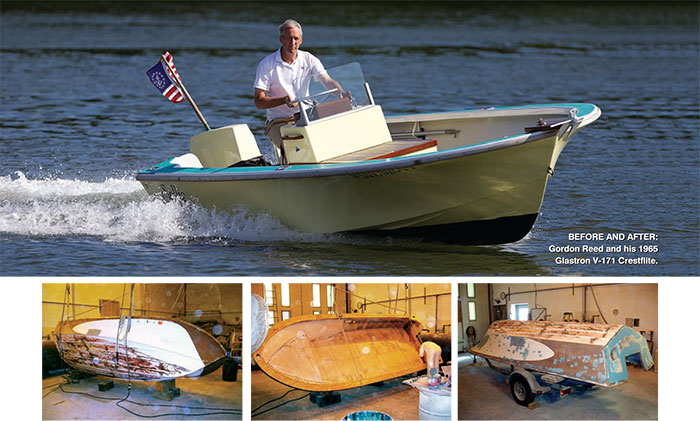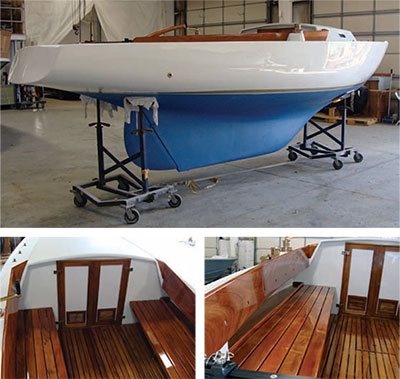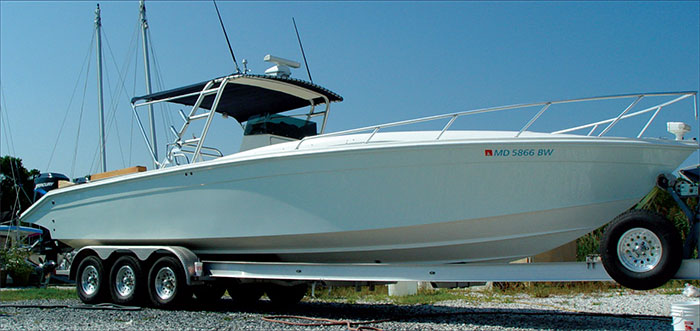
| Our Goal | Services | Job Photos | Job Videos | Media | Testimonials | Contact Us |
Ready for a Refit?

How to determine if your boat is a good candidate for an overhaul, and how to find the pros whose work won’t disappoint you.
By Chris Landry - Senior Reporter
From April 2012 Issue
Reprinted with permission from Soundings Publications, LLC.
Dollars and cents drive many backyard boat projects. Jeff Koenke didn’t have the money for a new boat, so he found a 1984 Boston Whaler Outrage 250 that was damaged in Hurricane Katrina and restored it.
“I paid $3,500, which isn’t a whole lot, and I have the title,” says Koenke, 46, who is from Sarasota, Fla. The restoration took about two-and-a-half years, and he has around $30,000 invested in the project. “I’m a patient kind of a guy, so the outcome is going to be better than most newer boats, and a new boat – fully rigged, turnkey – is $100,000-plus, and I can’t afford to do it that way,” he says. “I would rather just take a little extra time and scrape together money here and there and take on a project.”
Restoring an older boat can be an appealing option, whether it’s your current pride and joy or you’re looking to buy a fixer-upper. Perhaps you simply prefer older boats and their heavily built hulls. Regardless of your motivation, there are several factors to consider before you take that boat and repair the stress cracks, have it painted, upgrade the wiring and electronics, and rebuild the soft transom or deck.
First, there is the cost. If the price of a new boat is beyond your budget, a complete stem-to-stern refit also might break the bank unless you approach it in stages, especially if someone else will do the work. Also, restoration pros recommend having the boat surveyed – the hull, stringers, decks, transom – before committing to any work, even if you’re just improving the boat cosmetically.
And then there’s the pedigree. Whether it’s a beloved boat that’s been in the family for decades or a classic that you’ll keep or perhaps turn around and sell, there’s little sense in restoring a no-name brand, says Dan Patten, the owner of Dan’s Marine Fiberglass in Westbrook, Conn.
“It’s best to pick a popular design that excels in looks and performance, like a Donzi Sweet 16, which is equivalent to a ’55 to ’58 Corvette,” says Patten, 61, who also lists the Formula 233, Bertram 31 and 20 Bahia Mar, 23 SeaCraft, Makos, Fountains, Tiaras and Blackfins as good candidates. “Think of cars,” he says. “Would you restore a Rambler or a Pinto? I guess you could, but why?”
If the Pinto, like a family boat, had a lot of sentimental value you might. “With an old family boat, especially a family with kids that spent lots of time in the boat, it’s hard to let go,” says Steve Clancy, 55, of Newton, Mass., whose 1973 SeaCraft was restored by Metan Marine Restoration in Halifax, Mass. “I was initially inclined to go look for something new and bigger, but my kids were especially emotional about keeping the family boat – too many fond memories. These sentiments compelled me to invest the time and cash into the total restoration. Plus, when the boat’s a classic, that makes it easier, too.”
It’s not just the brand that matters but the era as well, says Wilco Marine owner Jodi Wilkinson. For example, Mako, Grady-White, Pursuit, Stamas and SeaCraft are trusted names, but watch out for boats manufactured in the early 1990s, says Wilkinson, 51, who established his repair and restoration shop in 1980 in Newbury, Mass. “Many boats had major gelcoat problems,” he says. “Gelcoat was cracking in stress areas because the gelcoats were being sprayed on too thick.”
When looking for a shop to work on your boat, be sure to go with an established business with plenty of experience in marine restorations, as well as solid knowledge of boatbuilding, he says. “You have to have a lot of technical background as far as being part-chemist and knowing boats,” says Wilkinson, who runs a small shop (one full-time employee and two part-timers) that works mostly on powerboats from about 15 to 40 feet. “A lot of these repair shops are glorified auto-body shops. We used to build boats for a living, and you have to know how to build a boat before you repair one. A lot of shops don’t want to hear that, but there are a lot of hack shops up and down the East Coast.”
“Find someone who knows the chemicals we use in this industry, someone who knows the difference between epoxy and ester-based resin and the lasting effects,” says Tommy Solomon, owner of Solomon Yacht Restoration, LLC in Edgewater, Md. “For instance, if your boat is built of an ester-based material, you should use an ester-based material for repairs. A chemical bond is far different than a mechanical bond and is precisely why so many repairs fall short of their expected life.”
That process is known as “matching the hatch,” Wilkinson says. “In a vacuum-bag repair you have to make sure the resin is the same kind that the boat was built with,” he says.
Bottom line: “Find someone who knows what he is talking about and plans to do the same job – in the same way – over and over again in the future,” says Solomon, who established his business in 1996.
The shop should also be able to provide proof that it produces a quality finished product. “Ask to see the shop’s work that is 3 or 4 years old, not six months and not what they’re currently working on,” Wilkinson says.
Solomon says a paint job is often unnecessary and that he points about a half-dozen customers a year to less-expensive options. “Some have gelcoat that was never taken care of properly and is oxidized to the max,” he says. In these cases, he says, wet sanding, using compounds and buffing can be done instead of painting.
It’s important to keep in mind that most restorations won’t put a lot of money in your pocket if you’re going to sell the boat, unless you do a lot of the work yourself, Wilkinson notes.
Carrying out a refit is a viable alternative to buying a new boat, and it usually brings great satisfaction to the owner. Another plus is the bragging rights an owner earns when the compliments come rolling in. “He has something unique to show off,” says Wilkinson.
‘Sustainable passion’ is a key ingredient

The owner of this 1963 Ensign hired Metan Marine of Halifax, Mass., to restore the sailboat after the company restored his 23-foot 1976 SeaCraft center console.
We’ve all seen them – the pollen-covered, leaf-filled, forlorn-looking boats sitting year after year on corroding trailers in boatyards and backyards.
Their owners had planned to restore them, dreaming of the day they would launch their like-new boats as family and friends look on in amazement. Too often, however, the dream remains a dream, typically because the owners lack what Gordon Reed calls “sustainable passion” for such an undertaking. “Even with all the money and time in the world, if you don’t have the commitment – that sustainable passion to see the project through – it’ll never happen,” says Reed, who restored a 1965 Glastron V-171 Crestflite. “It’s easy to have that passion to begin with, but it’s not so easy to maintain it a year and a half into the thing, when you’ve spent a bunch of money and you’re not even done yet – or even close to being done.”
Patience must prevail. “The key to having patience is knowing that at some point things are not going to go the way you want them to,” he says. “View the challenge as a positive, not a negative. If every issue that pops up is going to frustrate you, then you probably shouldn’t have started to begin with.”
In the last three years, Soundings has featured Reed and five other boat owners who have carried out major restorations and/or repowers. In addition to Reed’s Glastron (“Imagination spurs a restoration,” September 2011), we wrote about Steve Brady’s 1974 Sea Ray SRV180 runabout (“Memory lane makeover,” January 2012); John Abess’ 1977 21-foot Mako center console (“Refit of a lifetime,” December 2011); Jeff Koenke’s 1984 Boston Whaler Outrage 250 (“Patience pays off,” June 2011); Roland Robert’s 1984 Sisu 22 (“Better the second time around,” November 2010); and Jim Spalt’s 1989 Mako 261 (“Renewal comes in a refit,” May 2010).
Some boaters – such as Mako owners Spalt and Abess – hire professionals to do the work. “My time is better spent making money, although I would certainly enjoy doing some of the work myself,” Abess says.
Instead, he did lots of research and closely monitored each step of the project. “You should know the shortcomings or weaknesses of your existing boat, as well as what you want to have done to it in order to please you. This is very important,” says Abess, who spent a total of $45,000 on two refits, which included repowering twice, modifying the hull to accept an engine bracket and an Awlgrip paint job. “Learn what it would cost to purchase a new boat that would please you. This will help you make the commitment to upgrade your current boat.”
Do your homework before hiring anyone, Abess says. “They should come highly recommended by a number of people,” he says. “Their yard should seem busy, and you should inspect the work they have done on other boats to see if it meets your standards.” He also advises establishing an agreed-upon price and completion date before authorizing the work. Once the project is under way, the boat owner should be a meticulous record keeper.
Abess was very much a “handson” owner, says Bobby Gehlken, whose G-Crafts Marine in Awendaw, S.C., did most of the work on the Mako. “He took lots of pictures and documented the whole project,” Gehlken says. “We let him tell us what he wanted and we built it. He wanted it like he wanted it and we worked with him.”
If unexpected issues emerge – and they will – make sure the professional explains the problem and solution and clearly understands how you would like to proceed, Abess says. “This requires that you educate yourself about the options available for replacing components or rebuilding areas of the boat,” he says.
The components linked to the major portions of a refit often push an owner over budget, Spalt says. “Before you undertake the refit, very carefully estimate the costs,” he says. “My experience is you’re going to spend 20 percent or even 30 percent more than you anticipated because there are so many things you do not foresee in an old boat that creep up on you.”
Spalt spent about 30 percent more than he expected when he restored his Mako center console. “I figured I could use the same wires that I had for the new electronics, but the entire console had to be rewired,” he says. “With the fuel system, I thought I could have the fuel tank replaced and everything else would be fine. But it needed new fuel lines, and all the old lines had to be dug out. There’s just a lot of extras that end up costing you in materials and labor.”
Spalt had his boat’s twin 200-hp Yamaha 2-strokes replaced with a single Yamaha F350 4-stroke. He says that meant the engine controls and cables had to be replaced because the 4-stroke requires electronic fly-by-wire equipment.
Unlike Spalt and Abess, Steve Brady and Roland Robert carried out much of the work themselves. Robert and his two sons stripped and repainted the Sisu 22, replaced the fuel tank and steering system, and designed and built a hardtop with front and side windshields and a starboard-side helm console. “You need to decide how much you want to do on your own,” Robert says. “Let’s face it. There aren’t many easy things to do on a restoration. Decide what you can handle and be comfortable with. Replacing a transom requires a lot more effort than building a cabin door.”
Don’t skimp on materials, take your time and pay attention to details, says Robert. “Research the correct materials for whatever it is the project might be,” he says. “Use the marine-grade materials for plumbing, glass work and electrical. After all the effort that goes into a project like this, you want it to last as long as possible.”
Robert’s research started by visiting several boatyards and speaking with experts in the field. “I got a lot of great information on materials and applications, epoxy versus polyester resins, and core materials,” he says. “Plus, it got me motivated and on the right track.”
Use the Internet, too, says Brady, who did substantial wood and fiberglass work refitting his Sea Ray SRV180. “I didn’t know who to contact for what,” he says. “Google became my best friend.” Take advantage of the websites of marine supply companies such as West Marine and Jamestown Distributors, Brady says. “They give you a full page of information on whatever the project might be,” he says. “And Jamestown’s YouTube videos are invaluable because you can see what the project will entail.”
Know your limitations and know when it’s time to hire a professional, Brady advises. “I can work with fiberglass and with wood, but if you put me in front of an engine I may be able to do the basic jobs, but I certainly wouldn’t know how to rebuild it,” he says. “That’s over my head. And painting – I can paint, but it wouldn’t have come out as nicely as it did.” Brady hired Dan’s Marine Fiberglass in Westbrook, Conn., for the Imron paint job. He tapped Tom Krivickas, owner of Boat Works in South Windsor, Conn., to replace the Sea Ray’s transom and bought a rebuilt 1986 140-hp Evinrude 2-stroke.
Brady’s restoration took two years. “I could have finished it much quicker, but it’s the process and the project that make it worthwhile,” he says.
The restoration of Jeff Koenke’s 1984 Boston Whaler Outrage 250 took two-and-a-half years. The boat had suffered the wrath of Hurricane Katrina and needed a lot of work. The blistered hull had to be chemically peeled and sanded because moisture was trapped inside the laminate. Koenke did most of the sanding. Anticipating the completed boat sustained him through the hundreds of hours he dedicated to the project. “But I enjoyed the work,” he says. “You’ve got to have passion for this and you have to be patient.”
Passion and patience – there are those two words again.
A tale of two very different refits

The Marlin 350-SF that Tommy Solomon restored for himself had a good hull but needed a face-lift, including a redesigned console (before, during and after).

Boat restorations vary from project to project. Some boats might be structurally sound, but need updated wiring and electronics, plumbing or a paint job. Others might be weak in the knees and require a complete rebuild, starting with nothing but the bare hull. A 1994 Marlin 350 and a 1970 Formula 233 represent two different types of refits.
The Marlin 350-SF was a solid offshore center console in need of a face-lift when Tommy Solomon bought it in 2009. “For a boat of that vintage that was fished offshore to be in such good structural shape was amazing to me,” says Solomon, 49, the owner of Solomon Yacht Restoration, LLC in Edgewater, Md. “You would expect a boat like that to be torn up – riddled with stress cracks from one side to the other. They had fished this boat in tournaments year after year.”
The Marlin is Solomon’s personal boat. “I had a ball doing this one for myself,” he says. “Usually my work is for others, and I never made the time to find and work on a boat for me.”
A friend told Solomon about the deep-vee Marlin, which was listed on a website as a repossessed boat. “After thinking about it for a while and beating up the bank, I walked away with a fine catch,” says Solomon. “Did I ever get a great deal. It’s vulgar. I almost felt like going to church and asking for forgiveness.”
He worked on the boat as time permitted. It had a good hull, so he focused on the console and head. He worked with Engineered Marine Systems in Annapolis, Md., to rewire the helm and install electronics. The console structure was OK, but Solomon redesigned the panel layout for the electronics displays and other components, such as the molded section of fiberglass that houses the compass.
“All of the holes from the previous components were filled in with fiberglass and cut back out again,” says Solomon, who established his business in 1996.
He reinforced the console with wood panels encapsulated in fiberglass and vinylester resin. The wood provided a backing for mounting the electronics and switches. He also rebedded the bow rail, cleaned out the 250-gallon fuel tank, replaced all fuel lines, reinforced the transom with fiberglass and painted the hull, deck, console and leaning post with Awlgrip Awlcraft.
He had the boat repowered with twin 300-hp Evinrude E-TEC 2-strokes, and he installed Lenco trim tabs. Top speed is about 45 knots, with a cruise of 36 knots. “She rides in seas most center consoles would be tossed around in,” says Solomon, who continues to work on the boat. This winter, he made aluminum bezels for LED lights throughout the boat. The bulk of the refit took about five months, from November 2009 to April 2010.
Dan Patten spent about the same amount of time restoring a Formula 233, but the work was non-stop. The boat, which the owner bought for $300, came to Patten as a beat-up fiberglass shell. Another repair company had built a split-level composite deck (in two sections), and the original fuel tank was still under the cockpit sole. The original 233 from 1970 had a dual console, starboard helm, windshield and cuddy.
The upper part of the transom’s wood core was rotten. “The outer portion of the transom had millions of holes and gouges and grinding marks. It looked like it had been machine-gunned,” says Patten, 61, who owns and operates Dan’s Marine Fiberglass in Westbrook, Conn.
Patten used a plywood template that the owner had supplied to construct the deck cap for the transom, hull sides and bow. He fiberglassed together the two-section deck and glassed in fore and aft bulkheads. He glassed together the deck cap and hull, making this a seamless joint. And he painted the hull, deck and liner with Awlcraft and installed a rubrail.
Patten worked about 350 hours on the boat – a conservative estimate – and none of the work was simple, he says. “It definitely was a custom job, with challenges along most of the way,” says Patten, who began repairing fiberglass and painting boats in 1977. Case in point: the rubrail.
“Most of the rubrails have an overset to cover the overlap of the hullto- deck joint,” he says. “I needed one that did not have that overlap because the hull-to-deck joint is seamless. You wouldn’t believe how hard it was just to find one, and I still had to modify it.”
The owner had purchased a leaning post on eBay and a console from powerboat builder Contender. Patten worked with the owner to install the two components. The owner later had a T-top installed, as well as an Armstrong engine bracket, and he repowered with a pair of used 150-hp Yamaha 2-strokes.
Patten has restored about 20 boats since 2005, from a Dyer dinghy to a 1956 Atlantic 30 sailboat. The Formula 233 – the boat that marked the founding of Formula in 1962 by Don Aronow – and another Formula (a 1972 233), stand out as Patten’s favorite projects.
“Out of all the boats I’ve worked on, the changes that occurred in the renovation of [the 1970 Formula 233] were the most dramatic,” he says. “At the end, I looked at it and said, ‘Wow, I did that?’ ”
DIYers: You’re going to need some epoxy
Soundings asked three of the owners who completed restorations to identify a few tools and materials they used.
1984 Sisu 22, Roland Robert
- WEST System epoxy (hardtop fabrications)
- Penske board (for hardtop and transom)
- 3M sealants and adhesives (5200, 4200, 4000)
- Mas low-viscosity epoxy for sealing and coating mahogany
- table saw, circular saw, jigsaw, band saw and dual-action orbital sander
1965 Glastron V-171 Crestflite, Gordon Reed
- random orbital sander
- jigsaw, circular saw and band saw
- 3M sealants and adhesives (5200, 4200, 4000)
- epoxy (“Most of the popular types work well,” says Reed)
- air tools (“They’re great to have, especially the small right-angle grinder with a 2- or 3-inch 3M Roloc disc attachment.”)
- drills (cordless and electric) and plenty of drill bits, including tapered and countersinks
- particle masks, respirator, safety glasses, ear protection, paper suits and rubber gloves “by the boxful”
- small table saw
- pry bars
1974 Sea Ray SRV180, Steve Brady
- WEST System epoxy pumps. (“It’s a fabulous system,” says Brady. “Often, I found myself needing only a little epoxy. The pumps never harden when left alone, so I kept them on my workbench for ready access.”)
- 50-count box of paintbrushes and a box of latex gloves. (“They were cheap and convenient. My goal was to reduce setup and cleanup time.”)
- orbital and pneumatic palm sanders
- indoor work area. (“Not everyone can work in a climate-controlled environment all the time, but you have to keep your work dry. If it is not properly tarped and covered and water gets in there, you are starting all over every time you go to work on it. It’ll just kill the momentum of the project.”)
See pictures of the Marlin 350-SF Center Console (Memphis Belle) Here: Restoration Photos

United States Air Force Veteran
FI (4+5) G 30s 25ft Navy
Content and Photographs © Tommy Solomon
This site is for viewing purposes only. Not intended for instructional how-to or DIY.
Site design by Solar Flare Studios with Tommy Solomon as Creative Producer


